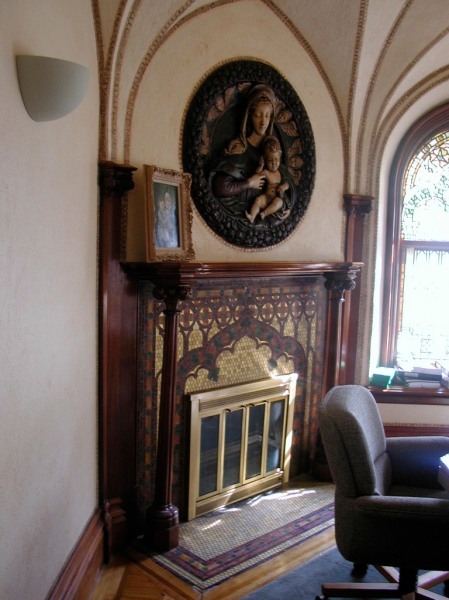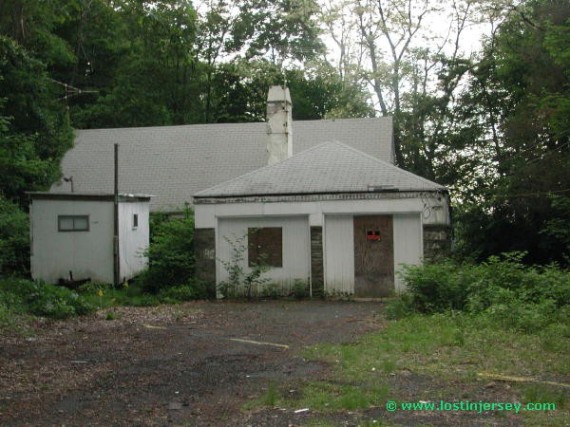Note: This blog entry was written in 2005 and, obviously, some things have changed. This article is presently being updated to include the changes.
Frederick Kip was a textile magnate who moved to the United States from Europe in 1902. The story, as it is commonly told, is that Kip’s castle was transported stone by stone from Europe to Montclair, NJ and reassembled next to the Klasztor Salvatorian Fathers Monastery. The 9,000 SF Norman Castle style mansion has 30 completely recreated rooms including the original stained glass windows, wood banisters, old-English quarter-sawn oak paneling, turrets, arches and deep set windows set on every wall – even a small chapel complete with mahogany mantelpiece. Large iron gates complete with giant stone pillars on either side frame the driveway entrance. The driveway itself is a long, winding switchback road that snakes up the hill in 3 lengths, the side of which is lit by lamp poles spaced every 50-100 feet.
I received an email from a relative of Kip which disputes the story I mentioned above, about how Kip’s Castle was built and its origins. Regardless of its origin, the castle in its heyday was large and ornate, but most of the internal beauty did not survive thanks to the actions of the second owners. In 1980 the Bhagwan Shree Rajneesh came to America from India, allegedly seeking medical treatment. In reality he was fleeing tax evasion and other criminal charges. The Bhagwan, a self appointed spiritual guru since the early 1970s, taught an eclectic doctrine of Eastern mysticism, individual devotion, and most notoriously, sex. His followers, many of them well-educated, middle class citizens, surrendered all their worldly goods to him, some even changing their names. By the time the Bhagwan came to the US, he had amassed over 400 centers world-wide with over 200,000 followers.
To announce his arrival in the US, the Bhagwan placed ads in Time magazine proclaiming spirituality through sexual freedom. He also purchased the castle after being influenced by his personal secretary, Ma Anand Sheela, who had attended Montclair State University. Residents of Montclair and the surrounding towns were not overly pleased with this development as hundreds, even thousands, of red-and-orange robed followers of the Bhagwan flooded into the area, renting or buying almost every available housing space just to be near their spiritual leader. “We are very concerned about our property values, our children and about this becoming an international HQ for a free-sex cult,” said one Montclair resident in a newspaper interview.
The Bhagwan promptly covered the old stone walls of the castle with sheet rock, the wood floors with linoleum, and the stained glass windows were smashed to allegedly prevent the followers from being influenced by “materialism”. But Montclair residents had no need to worry for long – the Bhagwan as it turns out, had bigger plans. The following year, he purchased a 65,000 acre ranch in Oregon and moved himself and his followers out of NJ.
The Bhagwhan called the Oregon property Rancho Rajneesh. The 100 square mile commune, eventually known as Rajneeshpurum had its own airport, restaurants, and police force. The Bhagwan would visit small local towns each day, slowly converting the town into part of his commune. The process was quite simple, and reminiscent of tactics used in European invasions. If you inject your own culture into another, eventually your culture drives out the original culture. When the Ranjeesh followers would finally outnumber the local residents, they would elect other members of the group to be mayor, council members and other political office. Before long, the nearby town of Antelope, Oregon was absorbed into the compound. (Looks like Montclair really dodged a bullet on that one!)
The Bhagwan’s success would not last, however. His second in command fled the country with a large amount of the Bhagwan’s money after she was accused of arson and attempted murder. She was arrested in West Germany and extradited back to the US. By now the Bhagwan had attracted the attention of several government agencies including the Attorney General’s Office as well as Immigration. He was arrested and charged with immigration violations, pled guilty to 2 counts and was fined 400,000 and forced to serve his suspended sentence outside the US. Much like that garbage boat which tried to enter country after country without success before being sent home, he finally was able to return to his native India where he died of heart failure a few years later. The city of Rajneesh, Oregon reverted to its original name Antelope, after the state determined that the conversion of the town violated separation of church and state.
Back in Montclair, in 1984, Kip’s Castle was bought by the law offices of Schwartz, Tobia and Stanziale (purchase price: $850,000). Nearly twenty years later, the lawyers are planning to move, and there is a very real chance that Kip’s Castle may be knocked down to create condos and townhouses. The asking price for Kip’s Castle, the carriage house and the 15 acres of property is $4.8 million, but it is believed that the proposed development is worth upwards of $30 million.
The future of the Castle is bleak, which is why the Preservation NJ website, which focuses on preserving historic buildings and properties that are threatened by neglect or development, considered it one of the most threatened properties in Essex County. It will take a great amount of money and willpower to buy the property and resist the urge to develop it in the manner which has been proposed. Clearly, there is big money to be made. It remains to be seen whether money or history will prevail.
I was really impressed with the castle. Inside & out you can tell it was made with high quality material and built with old fashioned quality hand construction. Sure, the inside now has standard plaster walls and modern lighting, but it’s not hard to imagine what this building must have been like at the turn of the 20th century. What will become of the property is still an unknown, but I will always remember my visit to Kip’s Castle. There simply is nothing else like it in North Jersey that I know of. The office manager was extremely nice and showed me just about the entire building, pointing out interesting features such as the expensive Dutch tile (called Delft) used to cover the walls of the bathroom, and the curved glass windows in the waiting area. I must say a big thank you to the law office of Schwartz, Tobia and Stanziale for granting me a brief visit to the property.
More pictures of Kip’s Castle can be found here



























